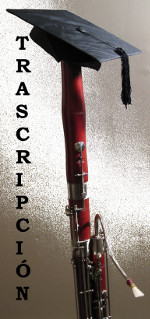Weissenborn Opus 8/2, Study #18 for advanced bassoon students.
Downward slurs. Practicing with rhythms that break pairings, beat
(metric) displacement. By Terry B. Ewell, Bassoon Digital Professor.
BDP#126. www.2reed.net.
Weissenborn Opus 8/2, Estudio Avanzado #18. Ligaduras
descendentes. Practicando con ritmos que rompen parejas, desplazamiento
de pulso. Por Terry B. Ewell, Profesor Digital de Fagot. Traducido por
Germán Martínez López. BDP #126.
www.2reed.net
TUTORIAL
1. Welcome, this is Terry Ewell. Study #18 focusses on mastery
of two things that are difficult to do on the bassoon: downward slurs
and balancing registers. On the bassoon it is easier to emphasize the
lower note when slurring a large interval. However, the downward slurs
should be performed without an accent on the lower note. In fact
Weissenborn even indicates that the upper note should be accented
leaving the lower note with a graceful resolution. In this study the
accents are made with increased air during the upper notes. Then you
need to diminuendo to the lower notes.
1. Bienvenidos, soy Terry Ewell. El estudio #18 se centra en
dominar dos cosas que son difíciles de hacer en el fagot:
ligaduras descendentes y equilibrio entre registros. En el fagot, es
más fácil conseguir la nota grave con un
intervalo ligado amplio. Sin embargo, el intervalo debe ser tocado sin
acentuar la nota grave. De hecho, Weissenborn indica que la nota de
arriba debe ser acentuada para dejar a la nota grave como una
resolución con gracia. En este estudio, los acentos se hacen
incrementando el aire durante las notas más agudas.
Después tenéis que disminuir a las notas graves.

2. The alternate F# fingerings in line 7 are to help motion to
Bb3. I mentioned the use of the little finger F# key in the last study
and I hope that you headed my instructions!
2. La posición alternativa de Fa# os
ayudará a moveros al Sib en la línea 7.
Mencioné el uso de esta llave del meñique en mi
anterior estudio. ¡Espero que hayáis seguido mis
instrucciones!


3. The second to last line in the study will need special
attention. These large leaps include confusing finger patterns. I
suggest you adopt these two methods of practice here and where needed
elsewhere in the study.
1) Rhythms that break pairings.
3. La segunda hasta la última línea merecen
especial atención. Estos amplios saltos pueden confudir los
dedos. Os sugiero que adoptéis eestos dos métodos
para practicar aquí y donde necesitéis en este
estudio.
1) Ritmos que rompen parejas.


4. Practice with both rhythms, eight notes followed by
sixteenth notes and sixteenths notes followed by eighth notes.
2) metric displacement
4. Practicad con ambos ritmos, corcheas seguidas por semicorcheas, y
semicorcheas seguidas por corcheas.
2) Desplazamiento métrico.

REFLECTION REFLEXIÓN
5. My sheep hear My voice, and I know them, and they follow Me. (NKJV,
John 10:27)
5. “Mis ovejas oyen mi voz; yo las conozco y ellas me
siguen.” (Juan 10:27, NVI)
6. These are words that Jesus spoke about his followers, His
sheep. We saw in the last video that Stravinsky’s change of
life was due in part to an answer to prayer. He heard God’s
voice and followed after Him.
6. Estas son palabras que dijo Jesús acerca de sus
seguidores, Sus ovejas. En el último video vimos que el
cambio en la vida Stravinsky se debió en parte a una
oración contestada. Él escuchó la voz
de Dios y le siguió.
7. So how does a person know whether it is the voice of God
speaking or the voice of evil forces? In the next few reflections I
provide a summary of an article by Harry Leesment that has been helpful
to me and others.
7. ¿Cómo sabe una persona si es la voz
de Dios hablando o es la voz de una fuerza maligna? En las siguientes
reflexiones daré un resumen de un artículo
escrito por Harry Leesment que ha sido de ayuda para mí y
otras personas.
8. Tone of voice. God’s
Spirit is gentle and imploring. In contrast evil forces are accusatory
and belittling. These other voices are harsh.
8. Tono de Voz.
El Espíritu de Dios es suave e implorante. En contraste, las
fuerzas del mal son acusadoras y menospreciadoras. Estas otras voces
son duras.
9. Specific vs. vague. The
Spirit of God points to specific actions you should take to correct
your relationship with God and others. The other voices tell you that
everything is wrong and there is really nothing you can do to fix it.
God directs you to a way out, the others state that there is no way to
free yourself.
9. Voz
Específica vs. Voz vaga. El
Espíritu de Dios señala acciones
específicas que debes tomar para corregir tu
relación con Dios y con los demás. Las otras
voces te dicen que todo está mal y realmente no hay nada que
puedas hacer al respecto. Dios te dirige a una salida, las otras
afirman que no hay manera de liberarte.
10. Encouragement vs. discouragement. God's
message encourages us to rely on His power not ours. The other voices
attack people, discouraging them.
10. Animo vs.
Desánimo. El mensaje de Dios nos anima a
confiar en Su poder, no en el nuestro. Las otras voces atacan a las
personas, desalentándolas.
CREDITS CREDITOS
Harry Leesment, The Evidence
(November/December 1985): 33.






